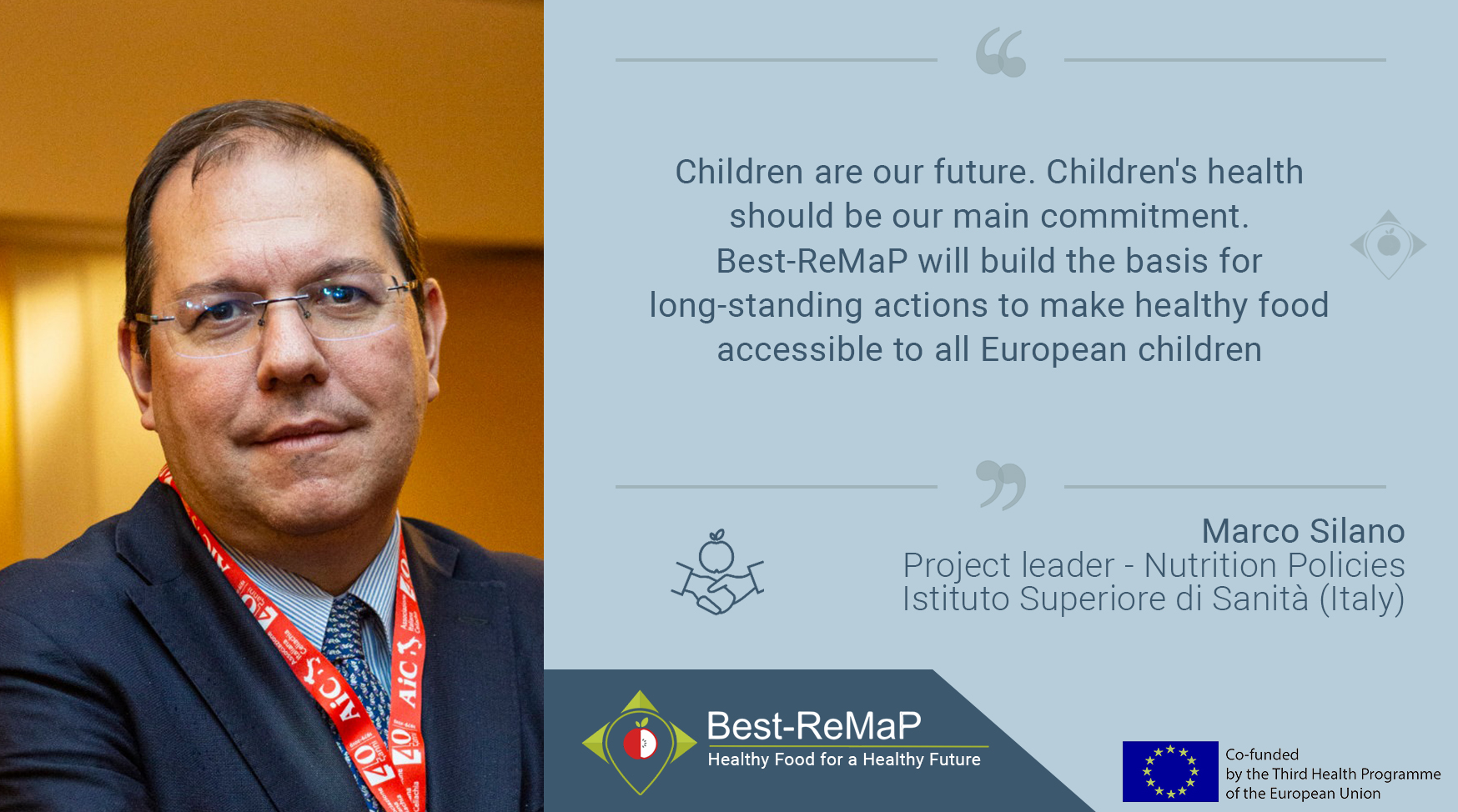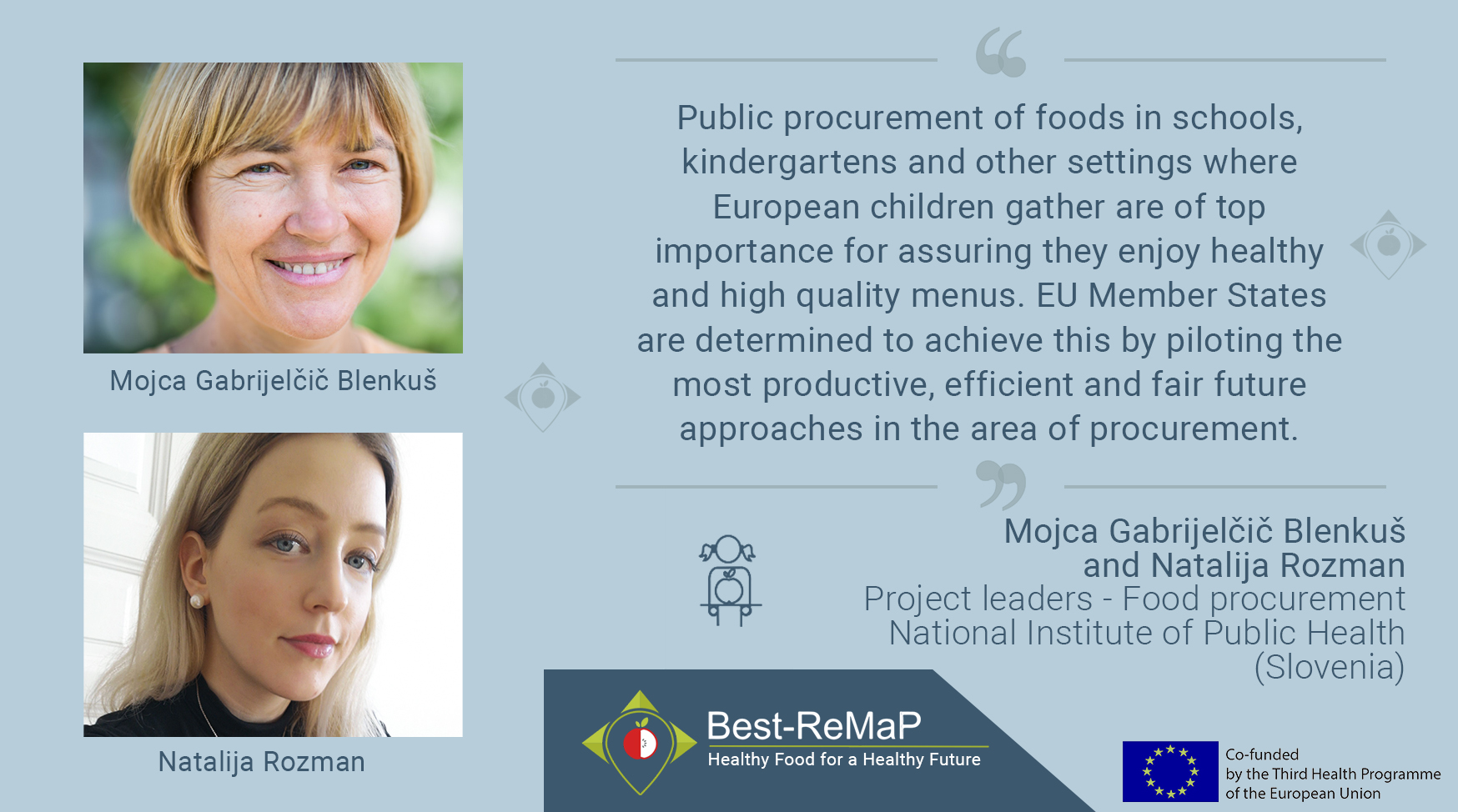Welcome to the 1st Best-ReMaP Newsletter
April | 2021
Welcome to the first newsletter of the Best-ReMaP (2020-2023), a Europe-wide Joint Action that seeks to contribute to an improved quality of food supplied to citizens of Europe by facilitating the exchange and testing of good practices. Below, we’ll explain how we plan to achieve this, introduce you to the team that’s going to make it happen, let you know what events to look forward to and, if monitoring nutrition policies is your area of interest, we’ve got some recommended reading at the end of this newsletter. Enjoy and bon appetit!
Your Best-ReMaP Communications Team

Albert Aszalos

Reka Kovacs

Maria Stambler

Špela Fistrič

Viktoria Kovacs

Eva Csecsodi
The Best-ReMaP journey begins!
Dear colleagues, partners and friends,
It is my honour to welcome you to the first newsletter of the JA Best-ReMaP. Going forward, we wish to use our newsletters to keep you up to date with the latest developments in the core Work Packages, as well as with the latest publications of the reports and announcement of upcoming events. Our plan is to publish another five issues throughout the course of the JA Best-ReMaP.
It is widely known that childhood obesity is a public health issue both in Europe and worldwide.
According to the European Commission, in 2017 around 15% of children and adolescents were overweight and about 5% were obese in the EU. With the COVID-19 syndemic ravaging the world, this poses even greater concerns. Combined with the risk of a global economic crisis, it may affect the most vulnerable populations that already bear a greater risk of obesity even more disproportionately. COVID-19 coupled with the economic crisis could lead to a huge growth of the obesity pandemic in the future. In fact, some results already point to an increase in childhood obesity and a decrease of their physical performance as a result of the COVID-19 syndemic.
All this makes JA Best-ReMaP’s goals, efforts and interventions even more significant than ever. Our activities should address the obesitogenic environment and provide more opportunities for European children to have a healthy diet. JA Best-ReMaP, engaging 24 Member States with a range of collaborating partners, has the power to do just this. We are going to concentrate on food reformulation, the reduction of unhealthy food marketing to children and public food procurement in order to ensure that healthy choices are the easy choices for children and their parents and caregivers, together with higher quality menus in school settings where children consume a significant portion of their daily food intake. We are also encouraged by the EU’s plan for beating cancer, where the defined actions of our JA are mentioned: “The Commission also supports Member States and stakeholders in their effort on reformulation of and on implementation of effective policies to reduce marketing of unhealthy food products, including through a Joint Action on Implementation of Validated Best Practices in Nutrition.”
In our ambition to reach our goals and truly make a big step towards changing food policies across Member States, we are networking with national and EU decision-makers. In addition, we are working closely with the representatives of various DG’s, OECD, WHO and other institutions. We are happy also to be cooperating with a team of brilliant professionals in the Steering Committee of JA Best-ReMaP, who are giving a strong boost to us all with their rich experiences in the field. In order to make an even greater breakthrough in our mission we have joined forces with big EU projects such as STOP, CO-CREATE, PEN and World Obesity Federation.
We are hopeful that with all the attention and support that we have been given, we could contribute to curbing and reversing the trend of childhood obesity. We are determined to make an impact, since we are convinced that when it comes to public health we have a responsibility to make healthier choices easier. I believe that together we can achieve great outcomes and give children a healthier start in life.
Enjoy reading our first newsletter!
Warmest wishes,
Mojca Gabrijelčič Blenkuš
Coordinator of the Joint Action, National Institute of Public Health of Slovenia
Meet the team! Focus areas of the project and who’s who
We want to ensure that each and every European citizen knows about and has easy access to nutritious foods. But how are we planning to achieve this? Our team is made up of some of the most leading experts in the field of nutrition in the EU, let us introduce them and our focus areas to you!

Nutrition policies (WP4)
Problems associated with poor nutrition and unhealthy eating habits have affected and will continue to affect many generations of Europeans.
Work Package 4 aims to support the implementation, transfer and integration of the results and outcomes of the Best-ReMaP Joint Action into national and EU-level policies in the areas of food reformulation, food marketing and public procurement of healthy food in public settings.
Read more about how we’ll turn project results into policies: https://bestremap.eu/policies/

Reformulation and processed food monitoring (WP5)
Currently, only a few European countries are able to monitor processed food supply at the brand level. Such a tool, at a country level, enables us to monitor food offerings and nutritional content, as well as to identify best formulation and room for reformulation. Activities aimed at reformulating foods into healthier alternatives are the first crucial step in improving the food supply for children.
Work Package 5 aims to share and promote best practices on how to implement a standardised European monitoring system for processed food reformulation.
After all, what gets measured gets done! Read more here: https://bestremap.eu/monitoring/

Food marketing to children (WP6)
Children are constantly exposed to marketing messages both offline and online. The information they receive affects their food choices. As eating habits are formed at an early age, getting the right nutrition information will give them a better chance to grow up to be healthy adults.
Objectives of Work Package 5 are to identify best policy practices to reduce exposure of children to marketing of unhealthy foods, and develop harmonised protocols and tools to monitor the extent and nature of marketing exposure of children.
Read more here: https://bestremap.eu/marketing/

Procurement of nutritious food in public institutions (WP7)
Oftentimes, the biggest obstacle to having a healthy diet is the absence of high quality food, especially in public institutions such as schools, kindergartens, hospitals, etc. Considering the amount of time that children spend at school, as well as the fact that in many European countries children consume at least one daily main meal there, schools are an ideal environment for supporting healthy behaviours.
Work Package 7 takes on a pilot approach across the EU to contribute to the higher quality of menus by assuring transparent quality of the procured foods in the selected public institutions of the interested Member States. With a view for the long-term, the project’s findings and recommendations will be implemented at the regional, national and EU levels to improve food choices for children, thus adding to increased healthy life years.
Read more here: https://bestremap.eu/procurement/
Project evaluation, coordination and communication

Save the date! Best-ReMaP Mid-term Conference
We’re very happy to announce the date and preliminary program for the JA Best-ReMaP Mid-term conference:
- What: Joint Conference together with STOP Project: Allowing the research knowledge translation to support policy decision making implementation
- Date: 17th and 18th of November 2021
- Location: Ljubljana or online – depending on pandemic situation
Programme: 1st day 17th of November – STOP‘s Third Childhood Obesity Stakeholder Conference and Dialogues & 2nd day 18th of November – JA Best-ReMaP Mid-term Conference

Recommended reading
As many of you might know, nutrition-related policies are essential in the fight against noncommunicable diseases (NCD’s). This WHO fact sheet assesses the different types of third-party food sales and composition data that are available across the WHO European Region. This is a highly useful guide to the characteristics, availability, and strengths and limitations out there. It details how these data can be used to monitor policy effectiveness and provides best-practice case study examples. We would love to know what you think, so please send us your feedback here.
We’re on social media
To stay up to date with the latest developments of the Best-ReMaP project and to get interesting information about what’s happening on the nutrition front in the EU, follow us on Facebook and sign up for our newsletters.

The content of this website represents the views of the author only and is his/her sole responsibility; it cannot be considered to reflect the views of the European Commission and/or the European Health and Digital Executive Agency (HaDEA) or any other body of the European Union. The European Commission and the Agency do not accept any responsibility for use that may be made of the information it contains.


